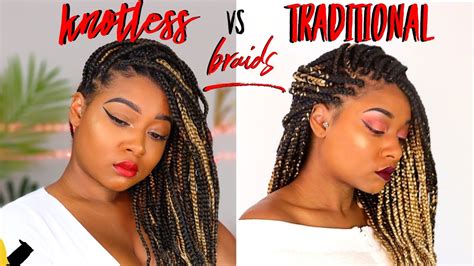Introduction
Box braids and knotless braids are two popular protective hairstyles that offer distinct advantages and aesthetics. While both styles involve braiding sections of hair, they differ in their techniques, maintenance, and overall appearance. Understanding the key differences between these two braiding methods can help you make an informed decision for your next protective style.

Box Braids: The Classic Choice
Box braids are a traditional African braiding technique that creates uniform square-shaped sections. The hair extensions are typically synthetic or human hair, and they are tightly braided into the natural hair close to the scalp.
Advantages of Box Braids:
- Versatile: Box braids can be styled in countless ways, from buns and ponytails to updos and headbands.
- Protective: The tightly braided sections protect the natural hair from breakage and damage.
- Long-lasting: Box braids can last for several weeks with proper maintenance.
Disadvantages of Box Braids:
- Time-consuming: Box braids can take several hours to install.
- Heavy: The weight of the extensions can cause strain on the scalp and hair follicles.
- Can lead to scalp irritation: The tight braiding technique can put stress on the scalp, causing itching and redness.
Knotless Braids: The Modern Innovation
Knotless braids, also known as feed-in braids, eliminate the knotting process involved in traditional box braids. Instead, the braiding technique involves feeding hair extensions directly into the natural hair, creating a seamless and less bulky result.
Advantages of Knotless Braids:
- Lightweight: The absence of knots reduces the weight of the braids, making them comfortable to wear.
- Scalp-friendly: The knotless technique minimizes tension on the scalp, reducing the risk of irritation.
- Natural-looking: Knotless braids blend seamlessly with natural hair, creating a more subtle appearance.
Disadvantages of Knotless Braids:
- Less durable: Knotless braids generally last shorter than box braids, as the lack of knots weakens the hold.
- Limited styling options: While knotless braids can be styled, the absence of knots limits the range of styles compared to box braids.
- More expensive: Knotless braids often require more time and skill to install, which can increase the cost.
Comparative Table
To provide a clearer understanding of the differences between box braids and knotless braids, here is a comparative table summarizing the key aspects:
| Feature | Box Braids | Knotless Braids |
|---|---|---|
| Braiding Technique | Knotted | Knotless |
| Hair Extension Weight | Heavier | Lighter |
| Scalp Tension | Higher | Lower |
| Maintenance | More frequent | Less frequent |
| Styling Versatility | Higher | Lower |
| Longevity | Longer | Shorter |
| Cost | Generally lower | Generally higher |
Which Braid is Right for You?
The choice between box braids and knotless braids ultimately depends on your individual preferences and hair type.
Consider box braids if:
- You want a versatile, long-lasting protective style.
- You don’t mind the weight of extensions or potential scalp irritation.
- You have coarse or thick hair that can withstand the braiding tension.
Consider knotless braids if:
- You prioritize scalp health and comfort.
- You want a lightweight, natural-looking style.
- You have fine or delicate hair that may be prone to breakage from tight braiding.
Common Mistakes to Avoid
To ensure the best results from either box braids or knotless braids, avoid the following common mistakes:
- Overtightening: Braids that are too tight can cause scalp pain and hair damage.
- Neglecting scalp care: Regular scalp cleaning and moisturizing is crucial for both styles to prevent irritation.
- Using low-quality extensions: Synthetic extensions that are not of good quality can break easily and cause hair loss.
- Not seeking professional installation: While some people may attempt to braid their own hair, it is recommended to visit an experienced stylist for optimal results.
Conclusion
Whether you choose classic box braids or modern knotless braids, both styles offer distinct advantages and can elevate your protective hairstyle game. By understanding the differences between these two techniques, you can make an informed decision based on your individual needs and preferences. With proper installation and maintenance, either style can keep your hair protected and looking fabulous for weeks to come.
